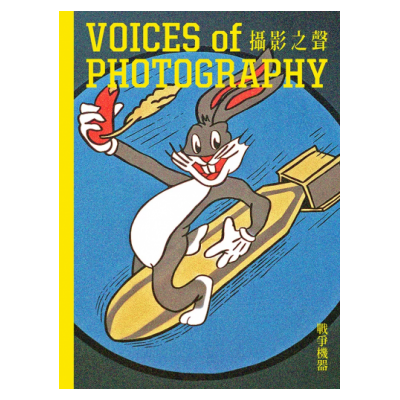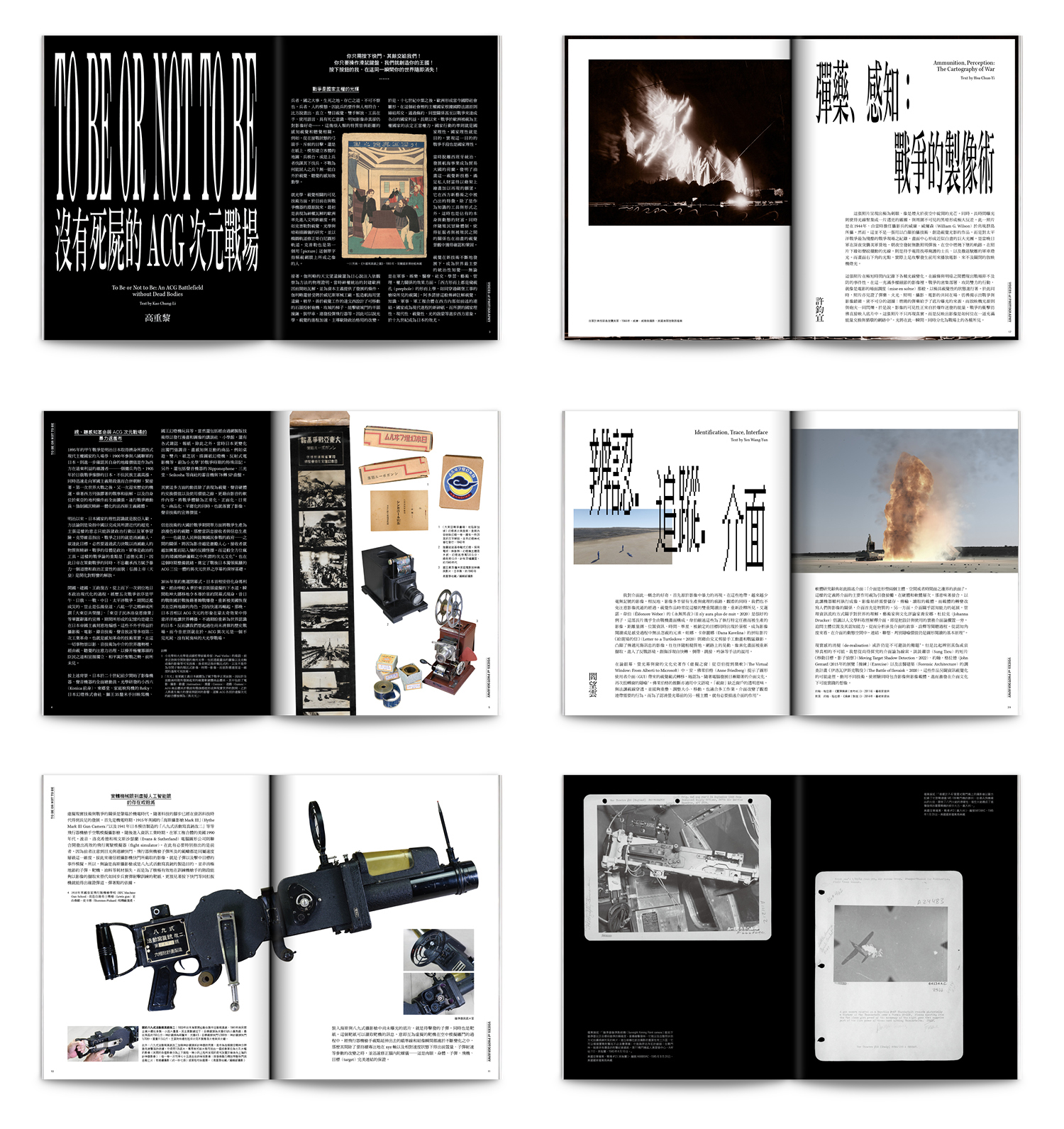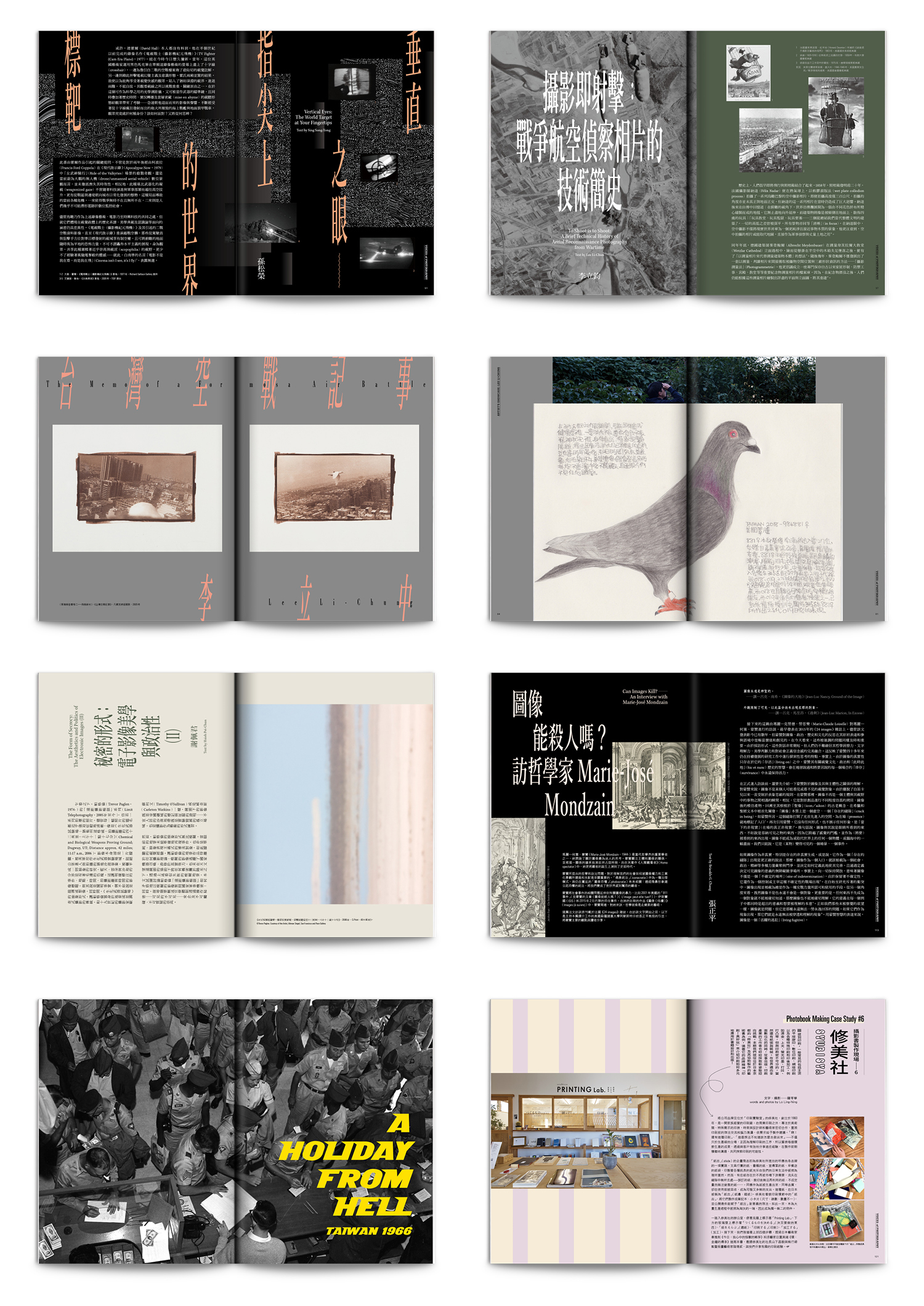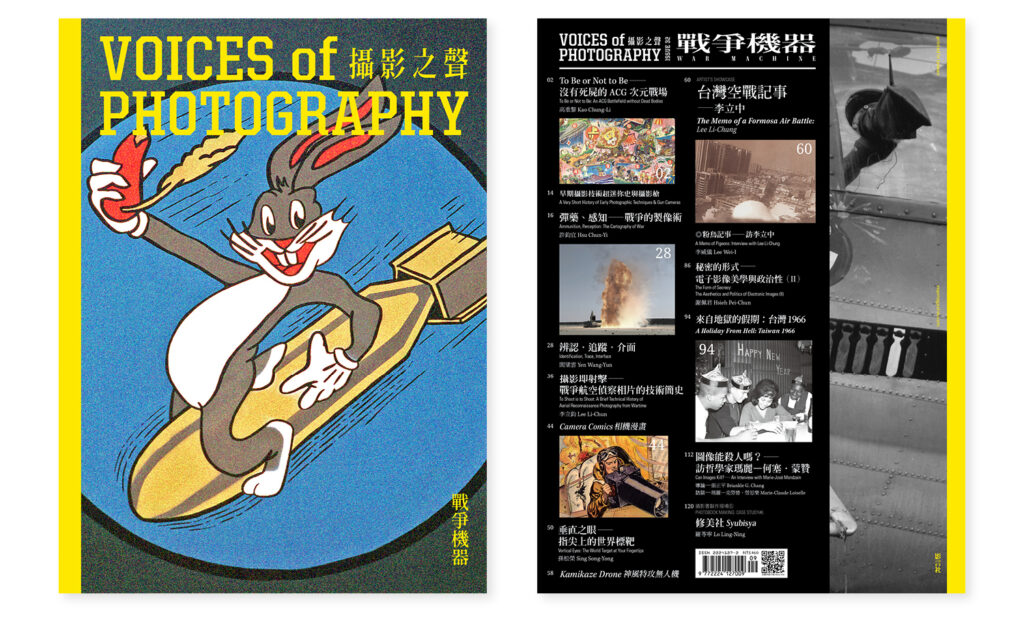
注意!戰爭就在「眼前」!
從望遠鏡、瞄準鏡、潛望鏡、攝影機具到雷達、衛星、無人機與視覺傳感技術的發展,光學史、攝影史與戰爭史之間呈現了同步推進的密切連結。正如哲學家維希留(Paul Virilio)所示,啟蒙之光迎來了攝影術與相機,迎來了連續攝影與電影,迎來了自動化武器,迎來了偵攻一體的光學軍備,迎來了視聽感知的轟炸交火,迎來了核彈爆炸後劇烈的「光」的照明⋯⋯。回想一下戰爭與攝影、電影、電玩遊戲相互繼承、共同演化的親密關係,一切並不奇怪──因為視覺機器正是戰爭機器。
在本期中,高重黎檢視光學與感知技術的發展史,探討自軍工複合體擴延的影音戰役,如何發展成以ACG征戰、由遠端遙測主導的光學戰場,又如何改變未來戰爭的知覺型態。以火藥的光爆和攝影的曝光、子彈的射擊和影像的擊攝,許鈞宜剖析攝影潛存的戰爭基因,演繹「所見即毀滅」的系譜關聯。李立鈞回探始於十九世紀中葉、自第一次世界大戰期間迅速開展的航空偵察攝影史,尋索世界何以化為需要判讀轉譯的技術圖像。孫松榮從錄像作品揭開由衛星、通訊網絡與航太科技層層部署的高解析上帝之眼,在權力縝密連線、由垂直向度帶來的實時監控與暴力威脅下,戰爭顯然已在我們的日常開打。
而閻望雲透過藝術家蕭崇(Sung Tieu)的無人機巡航視域、約翰.格拉德(John Gerrard)的軍事基地模擬繪圖與運算重建,以及藝術團體法醫建築(Forensic Architecture)蒐集大量數位影音檔案與地理資料、對烏俄衝突進行製圖與建模的戰事調查,深入資訊視覺化與再現戰爭的介面思索。謝佩君描寫崔佛.帕格倫(Trevor Paglen)的超遠距攝影,展示「模糊」如何作為國防軍事機密的武裝,以及可見的不可見之視覺戰略。「Artist’s Showcase」單元則訪談李立中,分享他由養鴿經驗開啟的創作系列,一探其以擬仿軍鴿飛行偵察與虛構文獻、所欲打開台灣空戰歷史與賽鴿文化政治的敘事想像。
此外,本期亦介紹罕見的攝影槍、光學兵器與發行於二戰時期的《相機漫畫》(Camera Comics);並揭載1960年代越戰期間駐越美軍執行「休息復原計畫」大舉來台渡假的攝影檔案,重新審視歷史巨大身影下隱微的戰線記憶與戰爭經濟。同時,也特別引介著名的法國當代哲學家瑪麗-何塞.蒙贊(Marie-José Mondzain)對視覺文化研究的關鍵概念並收錄其專訪,探究圖像、欲望、主體性、集體認同與社會文化環境的扣連,以及圖像如何作為展示權力的動態元素,而我們可以如何與視覺極權主義對抗。另外,「攝影書製作現場」系列,則由位於京都、重視印製與加工創意的修美社帶來特殊的製書實踐。
編輯台報告完畢,稍息之後請繼續閱讀,稍息!

Attention! War is “before your very eyes”!
From the development of binoculars, telescopes, periscopes and camera equipment to radars, satellites, unmanned drones and visual sensing technologies, the histories of optics, photography and wars show a close link marking their development. As philosopher Paul Virilio puts it, the Age of Enlightenment ushered in cameras and photography, chronophotography and movies, automated weapons, sensor to shooter optical military systems, the constant bombing of our visual and auditory perception, and the illumination from the intense ‘light’ that followed the nuclear bombing… If we think about it, it is not so strange that the trajectory of the evolution of warfare closely resembles that of photography, movies and video games, because the visual machine is in fact a war machine.
In this issue, Kao Chung-Li turns to the development of optics and perceptive technology and explores how the audio-visual battle expanded from the military-industrial complex field into an optics one, dominated by ACG (Animation, Comics and Games) wars and remote telemetry, and how that would change the perception of warfare in the future. Contrasting the light explosion from ammunition with the exposure from photography, and the shooting of bullets with the ‘shooting’ of images, Hsu Chun-Yi analyzes the war genes that are hidden in photography and deduces the genealogical relationship of what is meant by “to see is to destroy”. Lee Li-Chun goes back in time to the mid-nineteenth century to explore the rapid development of aerial reconnaissance photography during the First World War in order to understand why the world had to transform into technical images that needed interpretation and translation. Sing Song-Yong reveals how intricate layers of satellites, communication networks and aerospace technology come together to become the high-resolution Eyes of God, showing us how war is clearly upon us in our everyday lives under the threat of real-time monitoring and violence, carefully and tightly controlled by those in power.

On the other hand, Yen Wang-Yun puts together artist Sung Tieu’s unmanned drone cruising vision, John Gerrard’s simulation and reconstruction of a military base mapping, and a large database of digital audio-visual archives and geographical information amassed by the art group Forensic Architecture, who had conducted a mapping and modeling of the Russia-Ukraine conflict, as well as an in-depth visualization and reflection on the war. Hsieh Pei-Chun describes how the ‘blurring’ of images could be used as a defense tactic to safeguard classified military information and a visible yet invisible visual strategy, all through Trevor Paglen’s ultra long-range photography. In ‘Artist’s Showcase’, we interviewed Lee Li-Chung who shared his series, inspired by his experience with rearing pigeons, that delves into a fictional narrative on aerial reconnaissance conducted through military pigeons, hence opening the door to one’s imagination about Taiwan’s political and cultural history of aerial combat and pigeon racing.
In addition, this issue will introduce rare gun cameras, optical weapons, Camera Comics, a comic book series published during the Second World War, as well as photo archives from the “Rest and Recuperation Program”, through which U.S. military personnel stationed in Vietnam in the 1960s traveled to Taiwan for vacation. These offer a relook into the memories and economy that stayed hidden under the enormous shadows of warfare. At the same time, we also make a special introduction of Marie-José Mondzain, a contemporary French philosopher, and the key concepts behind her research on visual culture. With an interview with her, we explore the connection between imagery, desire, subjectivity and collective identity with the sociocultural environment, as well as how imagery is being used as a dynamic element that demonstrates power and how we can fight against visual totalitarianism. Further, in the “Photobook Making Case Study” section, we show you how books are made at Syubisya in Kyoto with a special process that emphasizes printing and creative processing.
This is the editor signing out, over. You may continue reading after falling out. At ease!

